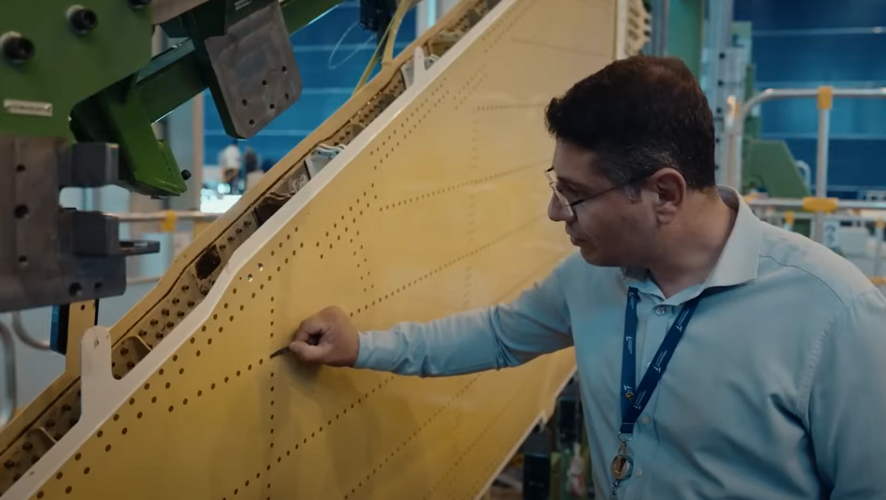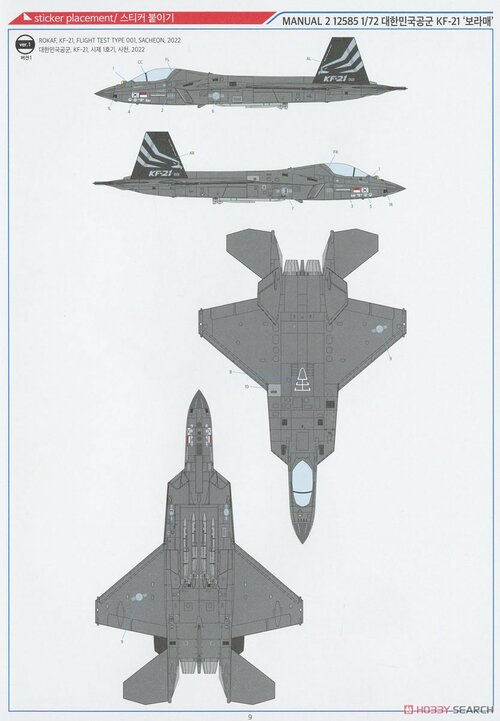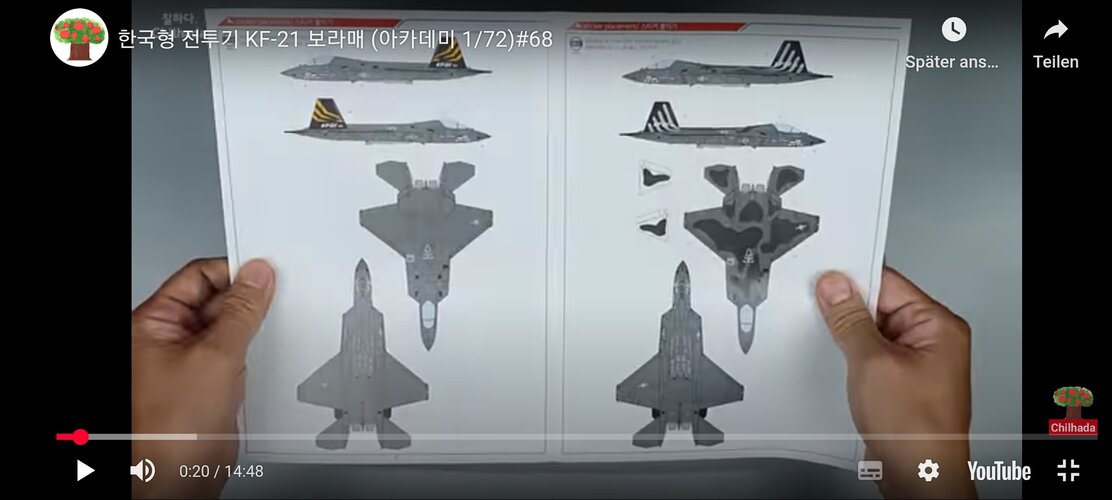You are using an out of date browser. It may not display this or other websites correctly.
You should upgrade or use an alternative browser.
You should upgrade or use an alternative browser.
KAI KF-21 Boramae (KFX Korean Indigenous Fighter program)
snne
ACCESS: Top Secret
- Joined
- 3 July 2022
- Messages
- 1,385
- Reaction score
- 4,487
I think it is considered standard precision in military aviation, but it does indeed sound very precise to us normies.1-mil precision? That's very good.
I remember watching a documentary about the assembly of the first Hürjet prototype, and the Montage Manager had mentioned that they were drilling 2,500 holes into the wing with a permeability sensitivity of 25 µm (microns) in a 0.1 mm hole (more or less equal with only a tiny difference of 0.4 µm). So, although it is a standard procedure in aviation, these are indeed really tight tolerances for us.


Starts around the 10:30 mark, shockingly the auto-translate in English is actually comprehensible:
Last edited:
Scott Kenny
ACCESS: USAP
- Joined
- 15 May 2023
- Messages
- 11,331
- Reaction score
- 13,809
Anyone making plastic models yet?
- Joined
- 11 February 2010
- Messages
- 1,641
- Reaction score
- 2,677
- Joined
- 11 February 2010
- Messages
- 1,641
- Reaction score
- 2,677

KAI KF-21 Boramae (Plastic model) - HobbySearch Military Model Store
Our shop retails 1/72 KAI KF-21 Boramae (Plastic model) Academy 12585 Military Model on the Web. [Description of item] - The 4.5th generation jet fighter KF-21 Bora (Wakataka) jointly developed by the Republic of Korea and Indonesia is now available as a 1/72 scale completely new mold snap kit...

- Joined
- 29 November 2010
- Messages
- 1,772
- Reaction score
- 3,469
Korean, Indonesian Officials Meet in Jakarta to Revive Stalled KF-21 Project
Defense leaders discuss funding, technology-sharing, and stalled agreement amid unresolved data breach case
Shaman Harris
ACCESS: Confidential
- Joined
- 26 March 2025
- Messages
- 51
- Reaction score
- 23
Indians called TEDBF 5 minus gen...
Last edited:
Ainen
I really should change my personal text
- Joined
- 25 August 2011
- Messages
- 1,233
- Reaction score
- 1,633
This minus is very annoying, because some of the features of those aircraft are in advance of 5th gen, others don't match; since such planes don't stop to appear(and what does 6 gen minus means - 6 gen but with canards, or non-stealth with 6 gen electronics,or what?).Indians called TEBDF 5 minus gen...
I'm personally inclining more towards broad "2nd day" category; i.e. a type of workhorse multirole fighter, specified by lower maintenance requirements and higher payload carrying efficiency.
In this case, 2rd day fighter really covers anything not meant for high altitude operations in denied airspace. Regardless of generation, and probably regardless of specific level of stealth.
Like in the past, there could be a day fighter of 2nd, 3rd or even 4th generation(original YF-16 ... and probably F-16 itself, until AIM-7/amraam). Or, technically, there *could* be a pre-5th gen stealth fighter(F-117X), it just wasn't born. Or which generation of fighter was Sea Harrier mk.2?
Generation, as a term, implies certain period of time, or certain technology. KF-21(or indeed TEDBF) are of course the worst offenders here, but Gripen E/F is also somewhere around, as is Tejas Mk.2. Too much incoherent, inconsistent minuses and pluses(4.5? 4.75? What next, 4.875?).
Last edited:
Don´t forget that Russia still had S400 in Ukraine a couple hundred days past the 2nd... 
But I can understand that approach. It makes somewhat sense, apart from the strong emphasis on something we know is an unrealistic scenario. Why not simply call them what they are: a 100, 200 or 500 nautical miles generations...
Don´t want to be hard. Semi-Stealth makes sense and is relevant when you can afford qty and attrition. Ukraine could probably have win the Air battle if they had a couple of hundred Mig29 and the pilots that goes with it .*
*That´s why I am furious French President, Mr Macron, dilapidated the french air force aircraft reserve of... a couple hundred of Mirage F-1 that would have stood the fight nearly as much as Ukraine owned Russian derelict Mig29s. Qty matters.
But I can understand that approach. It makes somewhat sense, apart from the strong emphasis on something we know is an unrealistic scenario. Why not simply call them what they are: a 100, 200 or 500 nautical miles generations...
Don´t want to be hard. Semi-Stealth makes sense and is relevant when you can afford qty and attrition. Ukraine could probably have win the Air battle if they had a couple of hundred Mig29 and the pilots that goes with it .*
*That´s why I am furious French President, Mr Macron, dilapidated the french air force aircraft reserve of... a couple hundred of Mirage F-1 that would have stood the fight nearly as much as Ukraine owned Russian derelict Mig29s. Qty matters.
Ainen
I really should change my personal text
- Joined
- 25 August 2011
- Messages
- 1,233
- Reaction score
- 1,633
Yeah, day here is more of description of operational environment.Don´t forget that Russia still had S400 in Ukraine a couple hundred days past the 2nd...
1st day can maintain controllable loss rate against active SAM network, and can operate continuously over suppresed environment. It is, however, unavoidably hampered by the requirements of this capability.
2nd day can maintain controllable loss rate over suppresed environment, and can operate continuosly outside of effective enemy SAM coverage.
There may be better term, just not five minus, pretty pretty please.
This minus is very annoying, because some of the features of those aircraft are in advance of 5th gen, others don't match; since such planes don't stop to appear(and what does 6 gen minus means - 6 gen but with canards, or non-stealth with 6 gen electronics,or what?).
It's just giving too much attention to marketing or fan antics. Be it a planform-aligned, LO-looking (doesn't mean it actually is LO) fighter or not, KF-21 is clearly a 4.5th gen fighter. KAI calles it that way, ROKAF calls it that way, and its mission systems are designed that way, so that it operates like a proper 4.5th gen fighter.Generation, as a term, implies certain period of time, or certain technology. KF-21(or indeed TEDBF) are of course the worst offenders here, but Gripen E/F is also somewhere around, as is Tejas Mk.2. Too much incoherent, inconsistent minuses and pluses(4.5? 4.75? What next, 4.875?).
I think that the taxonomy of fighter generations is one of the better defined "generations" out there, and we don't need any of these "4.5th gen +, ++, 4.75th gen, 5th gen -," so on and so forth, whatever bullshit.
Scott Kenny
ACCESS: USAP
- Joined
- 15 May 2023
- Messages
- 11,331
- Reaction score
- 13,809
I want to disagree with that, because 4.5 has been defined in the past as "4th generation with modifications to reduce RCS" (prime examples being Rafale and Super Hornet).It's just giving too much attention to marketing or fan antics. Be it a planform-aligned, LO-looking (doesn't mean it actually is LO) fighter or not, KF-21 is clearly a 4.5th gen fighter. KAI calles it that way, ROKAF calls it that way, and its mission systems are designed that way, so that it operates like a proper 4.5th gen fighter.
I think that the taxonomy of fighter generations is one of the better defined "generations" out there, and we don't need any of these "4.5th gen +, ++, 4.75th gen, 5th gen -," so on and so forth, whatever bullshit.
I want to call it 4.75 generation because the airframe appears to be LO-shaped, but it has a bunch of 4th gen parts still in it.
KF-21 is clearly intended as LO by airframe shaping. They had the assistance of LockMart, to at least say "it took us a really long time to figure that out" in terms of what technologies to avoid in order to get the plane flying sooner. I'm specifically thinking of the skin-integrated antennas like the F-35 has but the KF-21 explicitly does not as an example here, and quite possibly a supersonic weapons bay.
I'm assuming that the avionics are on par with F-35. Not the same as, but of similar capability aside from applique antennas instead of integrated.
Yes, the first couple iterations are not using an internal weapons bay. IIRC it's the third production block that is intended to have the bay working.
It's also got 4th gen engines right now. IIRC there was an intention to make F414-sized supercruising engines.
LO shaping plus internal weapons plus 5th gen avionics plus 5th gen engines equals 5th gen aircraft, right?
In the case of the Rafale, this was done between the 1986 demonstrator and the 1991-1993 prototypes.because 4.5 has been defined in the past as "4th generation with modifications to reduce RCS" (prime examples being Rafale and Super Hornet).
Scott Kenny
ACCESS: USAP
- Joined
- 15 May 2023
- Messages
- 11,331
- Reaction score
- 13,809
And IIRC Rafale was introduced as "the first 4.5 generation fighter"In the case of the Rafale, this was done between the 1986 demonstrator and the 1991-1993 prototypes.
Ainen
I really should change my personal text
- Joined
- 25 August 2011
- Messages
- 1,233
- Reaction score
- 1,633
All eurocanards and their contemporaries with advanced aerodynamics sort of count, i.e. the stillborn 5th generation, as it was originally conceived.
True stealth left them without proper generation, but they're distinctive.
The trick is that reality has proven they weren't really stillborn. Fully functional air force doesn't work on stealth (1st day) aircraft alone, it just lacks sufficient sortie generation.
True stealth left them without proper generation, but they're distinctive.
The trick is that reality has proven they weren't really stillborn. Fully functional air force doesn't work on stealth (1st day) aircraft alone, it just lacks sufficient sortie generation.
Scott Kenny
ACCESS: USAP
- Joined
- 15 May 2023
- Messages
- 11,331
- Reaction score
- 13,809
Except the Eurocanards were supposed to enter service in the 1980s, not the 2000s. As such, they should be seen as contemporaries to the F-15C/D.All eurocanards and their contemporaries with advanced aerodynamics sort of count, i.e. the stillborn 5th generation, as it was originally conceived.
True stealth left them without proper generation, but they're distinctive.
The trick is that reality has proven they weren't really stillborn. Fully functional air force doesn't work on stealth (1st day) aircraft alone, it just lacks sufficient sortie generation.
Ainen
I really should change my personal text
- Joined
- 25 August 2011
- Messages
- 1,233
- Reaction score
- 1,633
Their demonstrators flew in mid 1980s, I.e. after F-15C entered service .Except the Eurocanards were supposed to enter service in the 1980s, not the 2000s. As such, they should be seen as contemporaries to the F-15C/D.
They were supposed to enter service in 1990s, as were original ATF and Soviet MFI/LFI. All - quite far from F-15 (stable design from the 1960s).
Peace dividend thrown everyone off by another 5-10 years. ATF got additional delay, because US decided not worth it w/o stealth.
Russians did the same after seeing YF-22, and just restarted.
In terms of F-15 specifically, it got comparable reshuffle only just now, in F-15EX (full digital design with fbw). But still the original airframe at its core, so 4++ and not 4.5.
Scott Kenny
ACCESS: USAP
- Joined
- 15 May 2023
- Messages
- 11,331
- Reaction score
- 13,809
Not even sure the EX deserves the ++, IMO.In terms of F-15 specifically, it got comparable reshuffle only just now, in F-15EX (full digital design with fbw). But still the original airframe at its core, so 4++ and not 4.5.
Not even sure the EX deserves the ++, IMO.
Yeah, I'd say the F-15F is gen 4.5.
Scott Kenny
ACCESS: USAP
- Joined
- 15 May 2023
- Messages
- 11,331
- Reaction score
- 13,809
I was trying to say it's just 4thgen. Still a 4thgen airframe, stable and no attempt at stealth, even if it does have a fancy radar installed in it now.Yeah, I'd say the F-15F is gen 4.5.
Typhoon & Gripen are 4th gen from the onset (see what airframe they were designed to replace). Rafale is a premature 4th Gen, built with a commitment for a mid-generation design that was halted midway for a lack of performances (stealth) and state willingness (large delay).
Rafale is hence a full 4th gen. airframe, that, let´s remind all, started as an IR WVR missile only Naval platform. Nobody calls an F-15 EPAWS a mid-generation fighter. Not even an F-15EX. It´s an upgrade.
Rafale is hence a full 4th gen. airframe, that, let´s remind all, started as an IR WVR missile only Naval platform. Nobody calls an F-15 EPAWS a mid-generation fighter. Not even an F-15EX. It´s an upgrade.
Last edited:
Ainen
I really should change my personal text
- Joined
- 25 August 2011
- Messages
- 1,233
- Reaction score
- 1,633
In most cases(there is no established terminology anyway, and people mix them up all the time), pluses more often points toward upgraded aircraft of 4th generation. I.e. they don't contradict your point.I was trying to say it's just 4thgen. Still a 4thgen airframe, stable and no attempt at stealth, even if it does have a fancy radar installed in it now.
I'll strongly stress, that this is more of observation, and not any established rule. People mix them however they want.
i.e. 4 gen is simply original capability from 70-80s: lookdown radar, turbofans, fox-2, high t:w and sub/transsonic maneuverability.
4+ is ¬1990s multirole capability;, Fox 3, TWS radar, DFRM, etc. This is sort of basic capability for current moment - it's outdated, but it's minimum standard for relevance.
4++ - phased arrays, HMDs, networking/data fusion, deep airframe upgrades(including stealth? Things such as F-18E or Su-35S). List is not absolute, things can be or not be there. Basically points towards state of the art non-stealth aircraft in 2010.
Note that both are quite applicable not just to new airframes, but also to properly and timely maintained old ones. FbW, for example, is important upgrade for F-15EX (allowing outsized/unbalanced munitions, for intance), but it doesn't mean F-15EX is magically superior to upgraded F-15E with same radar and EW system in aerial combat.
4.5, on the other hand, is more often about post 1980s airframes.
I.e. Su-35s is 4++, but not 4.5. 2010s F-15C with an/apg-63v3 is 4++(even if it's a 1980s airframe), but again, not 4.5.
Typical AdAS Rafale, is 4.5 - even if it's the PESA one(which >half of them still is). It may be behind the bar in terms of some electronics (individual components on F-15EX are far beyond F-22), but airframe and architecture are just well, well beyond 1960s.
The problem is, of course, what to do within 4.5.
Because JAS-39A can be described as the earliest 4.5 gen(by airframe, at least). JAS-39E goes there as well, even though both are of course massively unequal, and the latter will likely bully the former to ~144:0.
Last edited:
Standard F2 & F3 ?Typical AdAS Rafale, is 4.5 - even if it's the PESA one(which >half of them still is).
Ainen
I really should change my personal text
- Joined
- 25 August 2011
- Messages
- 1,233
- Reaction score
- 1,633
From first royale units to future F5, all technically would qualify as 4.5. I've never seen any substantiated division in-between(4.75, 5- rant, see above).Standard F2 & F3 ?
As @Maro.Kyo mentions, ROKAF themselves doesn't bother to separate them, even when they have an absolutely new ~2026-2027 aircraft.
Which in a way is sensible, because their tactical use and constraints are more or less identical. Why artificial boundaries?
snne
ACCESS: Top Secret
- Joined
- 3 July 2022
- Messages
- 1,385
- Reaction score
- 4,487
I think we should categorize them into '3-day' categories, so that the second day could be reserved for fighters that are in between generations (those that were developed much later than the first generation of stealth fighter jets), such as the Su-75, Kaan, AMCA, or KF-21B3.Yeah, day here is more of description of operational environment.
1st day can maintain controllable loss rate against active SAM network, and can operate continuously over suppresed environment. It is, however, unavoidably hampered by the requirements of this capability.
2nd day can maintain controllable loss rate over suppresed environment, and can operate continuosly outside of effective enemy SAM coverage.
There may be better term, just not five minus, pretty pretty please.
However, this '3-day' categorization could be applicable to any scenario, not just the current '6th gen vs 5th gen vs 4th+' comparison
Ainen
I really should change my personal text
- Joined
- 25 August 2011
- Messages
- 1,233
- Reaction score
- 1,633
The way I see how days are portrayed in articles, I don't think it works. You either can allow fighter operate over SAMs ("1st day"), or you don't("2nd day").I think we should categorize them into '3-day' categories, so that the second day could be reserved for fighters that are in between generations (those that were developed much later than the first generation of stealth fighter jets), such as the Su-75, Kaan, AMCA, or KF-21B3.
However, this '3-day' categorization could be applicable to any scenario, not just the current '6th gen vs 5th gen vs 4th+' comparison
If your stealth is old or substandard, then you don't get intermediate aircraft (as it will be still just as constrained by maintenance and bays, but still won't be able to perform offensive stand in), you're simply getting downsides of both.
I.e. aircraft is either, broadly speaking, survivable enough, or it isn't, and should give air force other advantages(sortie rate and payload capacity).
Otherwise, both categories can go obsolete all the same.
snne
ACCESS: Top Secret
- Joined
- 3 July 2022
- Messages
- 1,385
- Reaction score
- 4,487
Having 4th-generation engines does not handicap a 5th-gen fighter in the primary aspect of its air-to-air missions, which is head-on BVR.It's also got 4th gen engines right now. IIRC there was an intention to make F414-sized supercruising engines.
This is what these fighters have been primarily designed for, and it’s one of the key design aspects that separates a 6th-gen from a 5th-gen. The key factor in this primary, head-on BVR engagement between two 5th-gen fighters is the sensors (though still quite important, RAM would be of lesser significance than sensors in this case).
Would you say that an AL-41F1-equipped Su-57M performs worse against a 51-equipped Su-57M, or that a J-20 equipped with WS-10 or AL-31FM2 performs worse against a hypothetical J-20 retrofitted with WS-15 further down the line?
Or, let’s say the current production KF-21 actually comes with an IWB and conformal sensors, or the tech demo Kaan prototype gets equipped with all of its intended sensors. Would they perform worse in a head-on BVR fight compared to their subsequent, re-engined versions(everything else staying the same)?
Last edited:
snne
ACCESS: Top Secret
- Joined
- 3 July 2022
- Messages
- 1,385
- Reaction score
- 4,487
I'm not referring to 5th vs. 4.5th gen, though. What I’m thinking about is much broader in scope, covering 5.5th gen and beyond.The way I see how days are portrayed in articles, I don't think it works. You either can allow fighter operate over SAMs ("1st day"), or you don't("2nd day").
If your stealth is old or substandard, then you don't get intermediate aircraft (as it will be still just as constrained by maintenance and bays, but still won't be able to perform offensive stand in), you're simply getting downsides of both.
I.e. aircraft is either, broadly speaking, survivable enough, or it isn't, and should give air force other advantages(sortie rate and payload capacity).
Otherwise, both categories can go obsolete all the same.
Ainen
I really should change my personal text
- Joined
- 25 August 2011
- Messages
- 1,233
- Reaction score
- 1,633
I get your point, but those to me seem just other 1st day aircraft.I'm not referring to 5th vs. 4.5th gen, though. What I’m thinking about is much broader in scope, covering 5.5th gen and beyond.
We also have recent justification: very visibly, Russia paid for not having such aircraft (or proper 2nd day ones for the matter, since it's mostly an offensive classification).
Before, it seemed that broadband stealth will define 6 gen.
Since it isn't the case anymore (of course Americans get to decide), why bother.
We'll simply have to keep in mind, broadly, what's stealthy enough in x band for what.
Looking at the canopy and airframe, I think this is ejection test on KF21 Double seater
View: https://youtube.com/shorts/28nQrNFYeDc?si=yyTxLI_hg9nDvzW7
EmoBirb
Certified Meanie
- Joined
- 18 January 2025
- Messages
- 89
- Reaction score
- 124
It's just giving too much attention to marketing or fan antics. Be it a planform-aligned, LO-looking (doesn't mean it actually is LO) fighter or not, KF-21 is clearly a 4.5th gen fighter. KAI calles it that way, ROKAF calls it that way, and its mission systems are designed that way, so that it operates like a proper 4.5th gen fighter.
I think that the taxonomy of fighter generations is one of the better defined "generations" out there, and we don't need any of these "4.5th gen +, ++, 4.75th gen, 5th gen -," so on and so forth, whatever bullshit.
Imo, which fairly enough isn't an authority on the matter, people should just stick to commonly defined 1st, 2nd, 3rd, 4th, 5th and 6th. These .5 and ++ in my opinion are nothing more than trying to upsell improved avionics/radar on a legacy airframe by attempting to convey it as something cutting edge. So something like a Gripen E or MiG-35 is still fundamentally just a 4th generation fighter jet. Now if they'd be stealth, have IWBs and possibly supercruise, then they could be considered straight up 5th generation. I think these in-between are always just kind of redundant and born out of the notion that a "regular 4th gen" is outdated or otherwise negatively afflicted, when in fact it just means pre-stealth.
Obviously the discussions can be endless about generations being a marketing thing etc. however with how widespread their usage is among enthusiasts and to a degree even professionals, I think we're long past that.
Luckily KAI doesn't claim the KF-21 is a 5th generation fighter until the IWBs are introduced, which is in line with established criteria and actually honest marketing.

